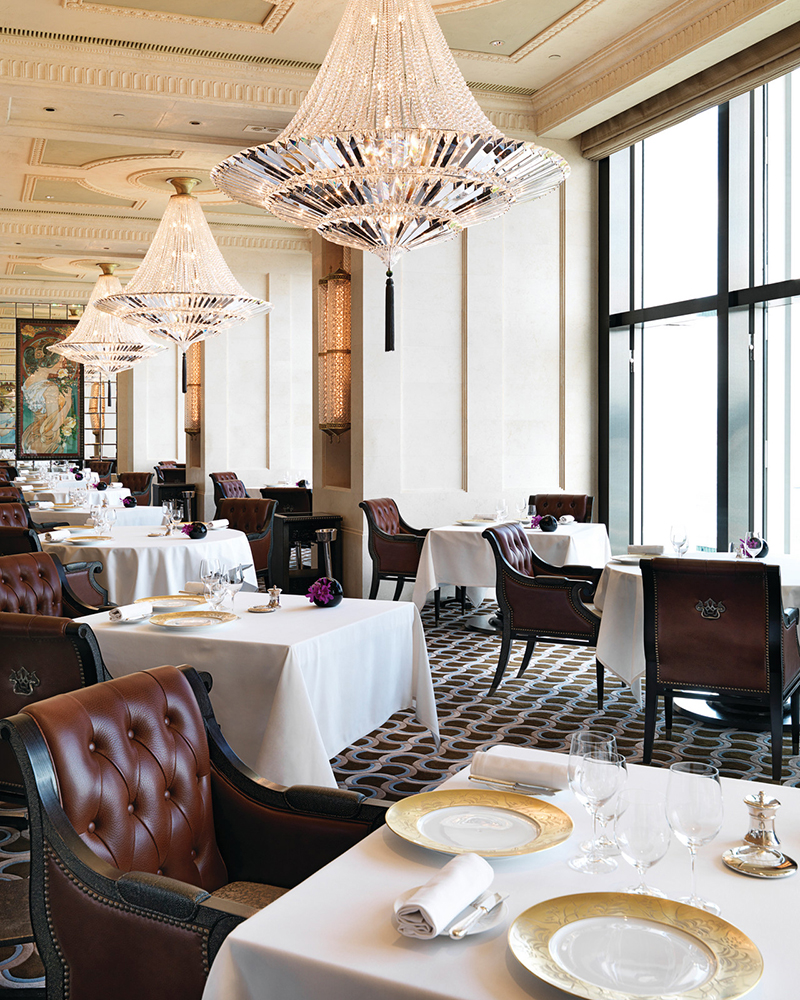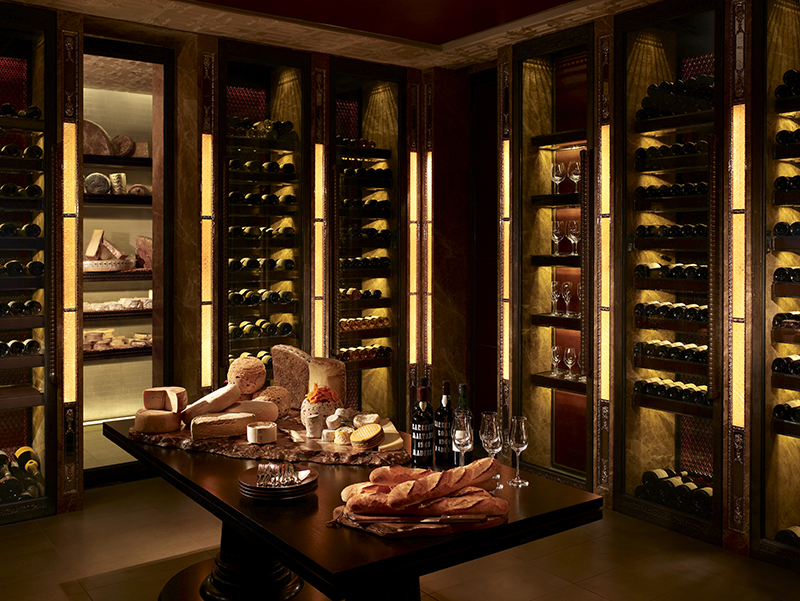

Pigeon Roti, Photo Credit: Four Seasons Hotels Limited
Originally from the Loire Valley in France, acclaimed chef Guillaume Galliot recently took the helm at Hong Kong’s beloved Forbes Travel Guide Five-Star Caprice. The luxurious address is known for its opulent interiors, superb wine and cheese selections, harbor views and, of course, flawless French cuisine.
Galliot has spent most of his career abroad, traveling the world from New York to Singapore, where he became the youngest sous chef in the history of the Four-Star Raffles Singapore hotel.
The top toque then moved with Raffles to Beijing before taking on a new challenge at Five-Star The Tasting Room, located within the City of Dreams hotel-casino complex in Macau — his most recent posting before joining Four Seasons Hotel Hong Kong’s Caprice.
The experimental gastro genius, who worked as a pastry chef early in his career, draws from his globetrotting experiences to craft a dynamic menu that blends classical French techniques with surprising flavor combinations — think crab laksa (a spicy Malaysian soup) with confit egg or a roasted pigeon dusted with cocoa powder.
We caught up with Galliot to hear how he’s mixing things up at one of the city’s most venerable French restaurants.

Caprice, Photo Credit: Four Seasons Hotels Limited
How did a kid from the French countryside find himself in Hong Kong?
I took a one-hour boat from Macau [laughs]. It’s been two months now in Hong Kong, and I’m extremely happy to be here.
Hong Kong is a totally different atmosphere than Macau. It’s easier to work here, too: Products are much more accessible, whereas the logistics make it harder to source things in Macau.
How do you go about sourcing products?
We only work with fresh products, which arrive every day. In Hong Kong, I can bring in products from Japan, France, Australia and China, so it’s much easier to experiment with the menu and get creative, you know?
For example, today we have a fresh calamari that isn’t on the menu, but I decided to prepare the dish à la minute. We are always playing with ingredients and thinking up new menu items spontaneously. It’s the freshness of the products and the cooking technique, of course, that make a product special.
It’s typical to see a lot of caviar and foie gras on a French menu. Do you use these staples, too?
Okay, sure, I have caviar, I have truffle, foie gras — all this sort of thing — but we don’t turn away from less prestigious products, either. Serving caviar doesn’t make a dish prestigious or sophisticated.
Just because you carry a Chanel bag does not make you classy. That’s not what I’m looking for. I’m more into finding less obvious products and creating that “wow” factor to surprise people.
For example, calamari is nothing prestigious in itself. We’ll make it refined by the way we prepare it. That’s my philosophy about cooking as well.
People always assume “the fresher, the better” with seafood. But how important is the timing?
It really depends on the fish and what I am planning to do with it. Knowledge of the product will help you decide.
Some products need to keep for a few days to develop some taste. Some Japanese chefs age their tuna — if you take a freshly caught tuna, slice and you put it in sushi, it will have no taste. They age it a few weeks, actually.
Other seafood, like calamari, is best when fresh.

Laksa with King Crab and Confit Egg, Photo Credit: Four Seasons Hotels Limited
How do you inject your personality into the menu?
Caprice is such a well-known restaurant. To be honest, I was a bit scared at the beginning.
I had a guest at the restaurant two nights ago. He was a good friend — also a chef and he will be honest about everything. He told me to cook whatever I wanted. But he saw one of my signatures on the menu, laksa, and he asked me, “No way, you serve laksa here? In Caprice?”
Yeah, of course. It is my dish and why not?
When I first arrived in Asia for work, I was based in Singapore. While I was there, I ate laksa all the time — just thinking about it makes me hungry! I love it so much.
I don’t serve it the traditional way — there are no noodles, and it’s not served in a large bowl like in Singapore. But laksa is the inspiration. We do a foam with the laksa sauce and there’s a mountain of crab in the middle.
So, what did your friend think of the dish?
Before my friend tried it, he was worried. But he said, “It works!” And people love it in Hong Kong. I can’t serve something that is not from me. I am not going to do another chef’s dishes — that’s not my style.
How else have your travels influenced your cooking?
I’ve been in Asia for 13 years already so, of course, when you travel, you pick things up naturally. But whether it’s Asian or French inspiration, I only cook dishes that I personally would love to eat. I think that’s important.
I don’t think you can cook something well if you don’t like it. You won’t have the same passion. You will not feel the sense of it — the approach is already wrong for yourself, so it can’t be right for the guest.
What’s your philosophy when it comes to presentation?
I think plating is important, but I am not going to pull out tweezers and have five people stand around one plate, spending too much time on it. We focus more on developing the flavors, the sauce reductions, the attention to detail in the cooking technique.
The pigeon dish [served with chocolate powder, beetroot and truffle shavings] is probably my most creative presentation. But again, it’s really more about creating layers of taste that go together well — the mint, the tarragon, truffle and chocolate. These very strong herbs will cut the earthy taste of the beetroot and the truffle. And served all together, it’s fantastic.

Caprice, Photo Credit: Four Seasons Hotels Limited
It’s more about flavor, and less about the way it looks?
Yes. For me, it’s about the emotion. It’s that moment when you take a bite and realize that it all works well together.
If someone says, “I never imagined this mix, but it works” — that’s a great feeling. I hope to surprise people. A memorable dining experience for me is based on taste. I would only use something like smoke, for instance, if it made sense with the dish. Just keep it simple.
How do you harness aromas in your cooking?
I take some inspiration from cocktails, actually. When I have a cocktail, I see the way the bartender takes the skin of a lemon and twists it, then lines the glass with the juice. The aroma hits your nose first before you drink.
That’s what we do, too. When the plate is warm and there is a bit of citrus zest, you will have this olfactive flavor coming out. Your mind is already ready to have this refreshing dish, just by the smell.
How does wine complement the dining experience at Caprice?
Having a strong sommelier at the front of the house is important. Sometimes, our sommelier [Victor Petiot] will come out and say, “Chef, the guest wants to bring this bottle — I just opened it. What can we suggest?”
And I will taste it and smell it, then try to adjust the recipes to go with that wine, so the dinner is customized for that guest, just like that. So, if you don’t have someone in front who is passionate or who isn’t always looking for ways to surprise the guests, then we miss opportunities to create a memorable experience.

Bar at Caprice, Photo Credit: Four Seasons Hotels Limited
How do you stay on your toes in the kitchen?
Once a dish is designed, it is not static. It evolves over time. With the pigeon dish, we change things up pretty frequently and it gets better and better. We are experimenting with so many different tastes and flavor combinations all the time.
Anybody can come in for lunch or dinner and order the Carte Blanche. It’s basically my version of an omakase menu [a Japanese chef’s menu] — whatever I’m experimenting with that day.
How do you think Caprice is different from other big-name restaurants?
Some big, big, famous restaurants in Europe have one menu. They sit you down, and it’s like you’re there for a show.
They tell you what to eat, when to eat it. And then if a guest asks for something a little different — no, it’s not possible. They don’t work for the guest.
This is not my philosophy of a great restaurant. When you come to my restaurant, you feel I can prepare a menu that’s just for you — four, five, 10 courses. If you come, and you just want to relax and order from the menu à la carte and keep it casual — fair enough!
Enjoy Caprice your way. We are very fluid and we keep an open mind. At the end of the day, the guest has to be happy, smiling and remember the experience.
